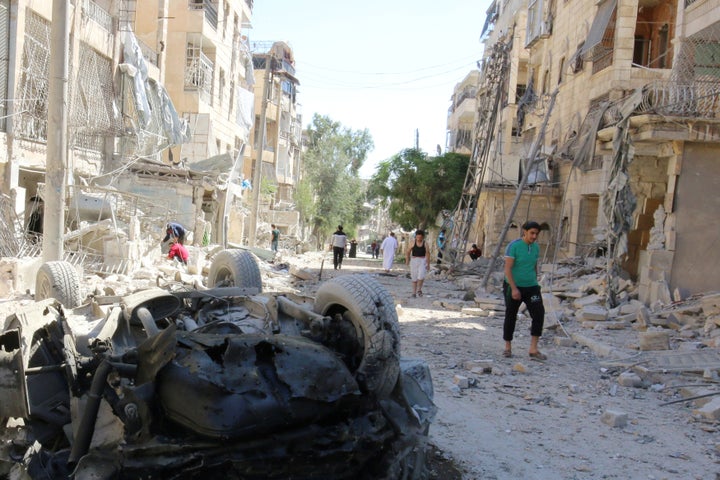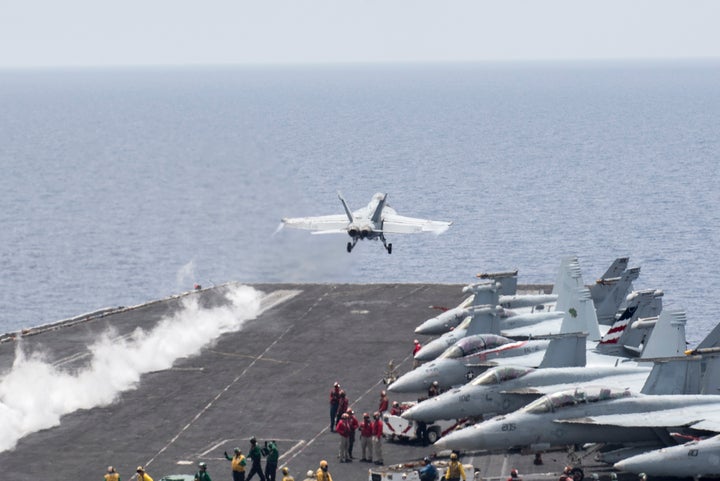
With hardly a mention of the conflict on the presidential campaign trail, the United States may soon face a critical decision in the Syrian war: whether to establish a no-fly zone to defend civilians against Russian and Syrian airstrikes.
The idea, long resisted by the Obama administration, has been endorsed by Democratic nominee Hillary Clinton and by prominent Republicans, Democrats and defense experts. It would declare a portion of northern Syria and perhaps southern Syria off-limits to Syrian and Russian aircraft, and would enforce it with air-to-air fighters and long-range cruise missiles.
A well-fortified no-fly zone would be a major escalation from the current U.S. posture, which is confined to air strikes and some training and support of friendly militias. But it could provide a safe haven for Syrian refugees and a training base for U.S.-backed rebel fighters. And it would be a thumb in the eye of Syrian President Bashar Assad.
A slim majority of Americans supports a no-fly zone despite the risks, reflecting their frustration that the United States seems to be doing nothing while Syrian civilians are dying in relentless Syrian and Russian attacks. Already some 400,000 to 500,000 people have been killed and half the population has been driven from their homes.
Despite the avalanche of grim news and gruesome images from Syria, however, a no-fly zone has received surprisingly little attention since Clinton mentioned it briefly last spring.
The ongoing siege of Aleppo, which followed the repeated collapse of negotiated cease-fire agreements, seems to signal a Russian intent to exterminate every last pocket of resistance along with the remaining civilians in that ruined city.
On Monday, the United States cut off cooperation with Russia over the Syrian war, seeming to further narrow U.S. options for a diplomatic solution there.
“People keep asking, ‘Is it too late?’ It’s not too late to declare a no-fly zone,” former CIA director and retired Army Gen. David Petraeus said on “Charlie Rose” last week.
“If the [Syrian] regime air force bombs folks we’re supporting or we’re concerned about, we tell them, ‘We’re going to ground your air force,’” Petraeus said. That threat would be backed up with readiness to take out Russian or Syrian aircraft and air bases with strike fighter and cruise missiles launched from outside Syrian airspace from American bombers or Navy ships, he said.
“That’s what we’re all talking about,” Sen. John McCain (R-Ariz.) told Defense Secretary Ash Carter at a recent hearing of the Senate Armed Services Committee, which McCain chairs. “A no-fly zone so we can protect these people from being slaughtered.”
Clinton has voiced the same rationale. “I do still support a no-fly zone,” she said during a Democratic debate with Sen. Bernie Sanders (I-Vt.) in April, “because I think we need to put in safe havens for those poor Syrians who are fleeing both Assad and ISIS and so they have some place they can be safe.”
Donald Trump has avoided the issue. “I don’t think so,” he said a year ago, when ABC’s George Stephanopoulos asked if he would, as president, order a no-fly zone. “I think what I want to do is, I want to sit back and I want to see what happens” in Syria, Trump said.
Since then he has been even less specific. In the only major speech Trump has given on national security since he secured the GOP presidential nomination, he dismissed the entire Syrian war and ISIS by promising upon his inauguration to ask “my generals” to come up with a strategy within 30 days.
In a televised meeting Monday with a group of retired generals and admirals, Trump again declined to say what he would do about ISIS and Syria, explaining that he did not want to telegraph his strategy to the enemy.
Michael O’Hanlon, senior defense and foreign affairs analyst at the Brookings Institution, said it’s “fair to predict” that a no-fly zone is a likely move for the next administration.
There Are Risks
But O’Hanlon and others point out the risks and unknowns: If the Russians challenged a no-fly zone, would the U.S. really shoot down their planes? How many American ground troops would be needed to police and defend a no-fly zone? If the war continued, how would the U.S. resist expanding its involvement?
“Yes, there are risks,” Petraeus said, “and those risks have increased and gotten more complicated. But if you don’t show you are doing something to prevent them [Russians and Syrians] from carrying out a war crime … there is considerable risk in not taking action.”
At a minimum, a modest no-fly zone could be established from outside Syrian airspace, as Petraeus suggested. One concept defense experts have raised is defining an area 20 miles deep along Syria’s northern border with Turkey and a similar area along the southern border with Jordan, with networks of radars and U.S. Patriot and Hawk air defense missile batteries stationed in Turkey and Jordan to threaten any Syrian or Russian aircraft infringing on those zones.
But Russian and Syrian air strikes are taking place largely outside these areas, and presumably would continue unabated.
A more ambitious no-fly zone, detailed by the Institute for the Study of War, an independent Washington think tank, could stake out a footprint 50 miles deep and 80 miles wide along Syria’s northern border with Turkey, including the city of Aleppo, with a similar area along Syria’s southern border with Jordan.
Because this zone would deny airspace currently used by Russian and Syrian jets, it would require burly defenses: fleets of F-15 jet fighters for air-to-air combat, along with carrier-based Navy F-18s to destroy Syrian anti-aircraft missile sites. Also required: aerial fuel tankers, AWACS command and control aircraft, Hawkeye tactical early-warning jets and guided-missile cruisers on station in the Mediterranean, according to the Institute’s analysis.

S. Truman to strike targets in the Middle East.
An even more audacious idea is to prohibit all flights by Russian and Syrian aircraft over all of Syria ― in essence, forcibly grounding their air operations. In a Senate Armed Services hearing Sept. 22, Joint Chiefs Chairman Joseph Dunford said, in a remark gleefully repeated by Russian media, that this idea “would require us to go to war against Syria and Russia. … That’s a pretty fundamental decision that certainly I’m not gonna make.”
But even the two lesser options for a no-fly zone raise serious issues, apart from the risk of armed clashes between American and Russian forces.
A large no-fly zone might end the bombing in Aleppo, but it would not stop the killing taking place further south in the Damascus suburbs, and it probably would not bring the war to a halt.
How Would It End?
As McCain has admitted, “There’s always risk of a wider war. There are always risks in anything we do.” As with any risky, large-scale military operation, a critical question is: What’s next?
“How would it end?” President Barack Obama wondered during a press conference last November. The U.S. imposed and enforced a no-fly zone over Iraq from 1991 for more than a decade, with the Air Force struggling to maintain a near-constant air presence of fighters and bombers. It ended only with the invasion of Iraq in 2003.
In Syria, a no-fly zone would carry the “potential for open-ended commitment with no significant change in the situation on the ground,” the analysis by the Institute for the Study of War noted.
It’s not difficult to anticipate that if the war continued to rage, pressure on Washington to deepen its military involvement might increase, especially if Americans were killed defending the no-fly zone.
That kind of “mission creep” is how the United States got bogged down in Somalia, an operation that began with a benign humanitarian mission in 1992 and ended with 43 Americans dead and a humiliating U.S. retreat.
Another issue, one raised by Obama during a press conference last November: “Who would come in and out of that safe zone?” In the crush of people struggling to get into a U.S.-protected area, it might fall on U.S. military personnel to sort out civilians from ISIS fighters, terrorists and saboteurs.
“There are a whole set of questions that need to be answered there,” the president said.
